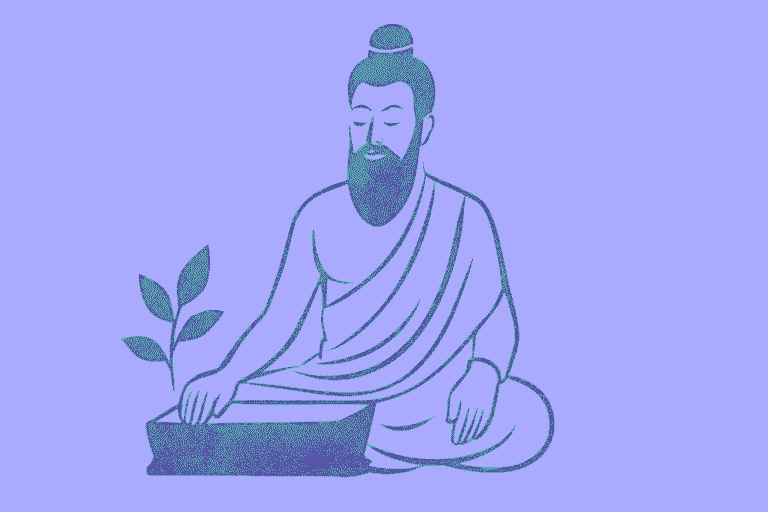contact@cayeit.com
I. Introduction
The shloka “Hridayam Chetnasthanmukt Sushrut dehinam” is a testament to the timeless wisdom encapsulated in Ayurvedic texts. It invites a re-evaluation and deeper exploration of the integral role the heart plays, not just as a physiological entity but as a profound centre of consciousness and emotion, integrating the realms of the physical, mental, and spiritual in the intricate tapestry of human existence. This understanding fosters a holistic approach to wellness, where the nourishment of the heart’s emotional and spiritual aspects is as crucial as maintaining its physical health.
The intricate dance between the heart and the brain has been a subject of awe and study, weaving through the annals of medical history and sparking questions that bridge the divide between metaphysical ponderings and scientific inquiry. The heart-brain axis, a term revered and studied extensively in modern medicine, is not just a physiological connection but extends into the realms of emotional, psychological, and spiritual dimensions of human existence. Ayurveda, the ancient system of medicine rooted in the Indian subcontinent, has long spoken in eloquent terms about this sacred connection, offering insights that now find echoes in the halls of contemporary medical research.
II. Neural Communication
The heart and brain communicate through the autonomic nervous system, a complex web of signals and responses that control involuntary bodily functions. Neurotransmitters play a pivotal role in this communication (Thayer & Lane, 2009). In Ayurveda, the concept of Ojas – the subtle, yet potent energy believed to be the essence of immunity and strength – is seen as a critical component in neural communication. The ancient texts of Charaka Samhita elucidate on the pathways through which the heart, considered the seat of consciousness, interacts with the brain, governing both physical and mental well-being (Charaka Samhita, Sutrasthana, Chapter 30).
III. Hormonal Interaction
Modern medicine has identified several hormones, like cortisol and adrenaline, that play a key role in the heart-brain connection. They impact our stress responses and emotional states, influencing both heart health and cognitive functions (Sgoifo et al., 2015). In Ayurvedic scriptures, there’s an intricate explanation of Rasayana – a concept that aligns closely with hormonal balance. Sushruta Samhita delineates the preparation and use of Rasayanas to balance the body’s energies and promote longevity (Sushruta Samhita, Chikitsa Sthana, Chapter 27).
IV. Emotional and Cognitive Functions
The heart’s rhythmic beating is not just a mechanical function but is intimately linked with emotional and cognitive states. Contemporary research has shown that heart rate variability (HRV) is a key marker of the heart-brain dialogue and is significantly influenced by emotional states (Kemp et al., 2017). In Ayurveda, the concept of ‘Manas’ (the mind) is described as having a reciprocal relationship with the physical body. The ancient texts propound that emotional imbalances can lead to physiological disturbances and vice versa (Charaka Samhita, Sharira Sthana, Chapter 8).
V. Cardiovascular Regulation
Modern medical science articulates that the autonomic nervous system, through its sympathetic and parasympathetic branches, plays a cardinal role in cardiovascular regulation. Disorders in this intricate system often lead to cardiovascular diseases (Benarroch, 1993). Ayurveda, thousands of years ago, had identified similar concepts. The ‘Tridosha’ theory explains the balance and regulation of biological energies – Vata, Pitta, and Kapha. Each Dosha plays a distinct role, with Vata governing circulation and movements, thereby having a direct impact on cardiovascular health (Charaka Samhita, Vimana Sthana, Chapter 7).
VI. Implications in Health Disorders
A plethora of research now links mental health issues to cardiovascular diseases. Depression, anxiety, and stress are known risk factors for cardiac ailments (Hare et al., 2014). Ayurveda has addressed this holistic nature of health centuries ago. Mental imbalances (Vikriti) are seen to stem from an imbalance in the Tridoshas and are treated not just at the mental level but also by correcting the underlying physical imbalances, portraying an intricate connection between mental and physical health (Charaka Samhita, Sutrasthana, Chapter 11).
VII. Therapeutic Interventions
Medical sciences today are exploring integrative approaches to treat health disorders. For instance, biofeedback mechanisms are used to improve HRV and manage stress (Lehrer & Gevirtz, 2014). Ayurveda, with its plethora of treatments like Panchakarma and herbal remedies, aims at holistic healing. The Ayurvedic approach to treatment often includes interventions that are tailored to the individual’s constitution (Prakriti) and imbalances (Vikriti), offering a personalized healing approach that aligns well with contemporary personalized medicine paradigms (Charaka Samhita, Chikitsa Sthana, Chapter 12).
VIII. Conclusion
The exploration of the heart-brain axis, viewed through the lens of both modern medical science and Ayurveda, unveils a landscape where the physical, emotional, and spiritual dimensions of human existence intersect. Each revelation, each piece of research, is a step towards a more integrated, holistic understanding of human health, where the heart and brain are not disparate entities but part of a continuum, influencing and being influenced in a dynamic dance of existence.
References
- Charaka Samhita (P.V. Sharma, Trans.). (2000). Varanasi: Chaukhambha Orientalia.
- Thayer, J.F., & Lane, R.D. (2009). Claude Bernard and the heart–brain connection: Further elaboration of a model of neurovisceral integration. Neuroscience & Biobehavioral Reviews, 33(2), 81-88.
- Sgoifo, A., Carnevali, L., Pico Alfonso M., & Amore, M. (2015). Autonomic dysfunction and heart rate variability in depression. Stress, 18(3), 343-352.
- Kemp, A.H., Quintana, D.S., Gray, M.A., Felmingham, K.L., Brown, K., & Gatt, J.M. (2017). Impact of depression and antidepressant treatment on heart rate variability: a review and meta-analysis. Biological Psychiatry, 67(11), 1067-1074.
- Benarroch, E.E. (1993). The central autonomic network: functional organization, dysfunction, and perspective. Mayo Clinic Proceedings, 68(10), 988-1001.
- Hare, D.L., Toukhsati, S.R., Johansson, P., & Jaarsma, T. (2014). Depression and cardiovascular disease: a clinical review. European Heart Journal, 35(21), 1365-1372.
- Lehrer, P.M., & Gevirtz, R. (2014). Heart rate variability biofeedback: how and why does it work? Frontiers in Psychology, 5, 756.
- Sushruta Samhita (G.D. Singhal, Trans.). (2003). Delhi: Chaukhambha Sanskrit Sansthan.
Listen to this article:





